 |
|||||||||||
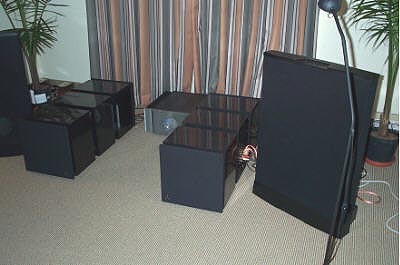 |
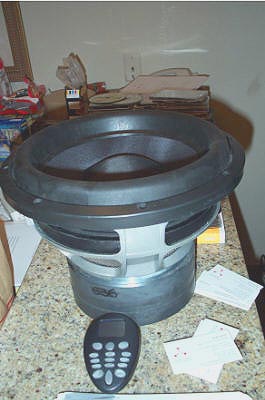 |
||||||||||
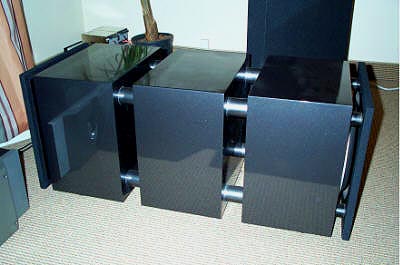 |
|||||||||||
Intelligent Audio Systems' marketing slogan? "It listens in Bluetooth, it thinks in Linux, it speaks with 2,000 watts of Class D power". Allow me to introduce you to Senior It: The Model IA-643 self-installing, auto-adaptive dual 12" active subwoofer module with claimed response to 16Hz. |
|||||||||||
With auto-detect digital, analog and speaker-level connections, each triple-chassis module responds to a remote control with integral calibrated condensor microphone and wireless digital bridge. It measures response at the listening seat and prompts the internal 400MHz XScale computer via bi-directional communications link to correct for crossover point and slope, time/frequency domain and radiation pattern, the latter including omni, dipole, cardioid or a hybrid combination thereof. The crossover itself is self-designing series/parallel and proprietary to IAS. Weighing in at 155 lbs per module [the above image shows one module], the dimensions are 15.5" x 16.5" x 36", with each portion containing a different part of co-developers Ken Kantor (formely of NHT) and Paul Bamborough. We're in Vegas, remember? The intelligent adaptive DSP algorithms are said to be far more advanced than previous attempts and eschew inverse-transform filters indicating that these are modeled on psycho-acoustics the way humans rather than microphones hear. Anyone with enough guts to use Quad electrostats as main speakers to demonstrate seamless integration of his subwoofer has my complete attention and respect. For the time being, this looks to be the most comprehensive, hi-tech, serious attempt at integrating full-range bass into any kind of room, with any kind of main speaker. I'm convinced and have been for a while that the future for speakers in general lies in digital crossovers - perfect time and phase response, ultra-steep slopes, infinite variability. Kudos to the engineers at IAS. Applying such groundbreaking design work to audiophile subwoofers intended to play music -- brains & brawn, who woulda thunk -- nearly smacks of pearls for swines when you consider how most people use subwoofers. |
|||||||||||
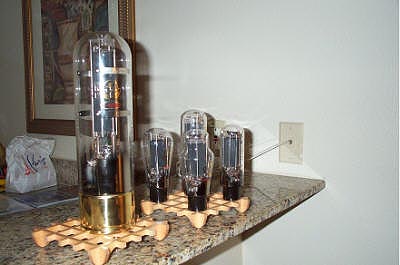 |
 |
||||||||||
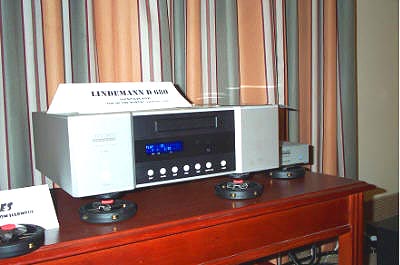 |
|||||||||||
The KR Audio room was home also to the Lindemann D-680 SACD player promised for review, as well as the HMS cables currently awaiting round two of my follow-up report. Eunice Kron remains commited to the future of the company her recently deceased husband Dr. Riccardo Kron created. She extends her sincere regards to all who've been supportive during this difficult personal transition. |
|||||||||||
| Small men with tube envy? Forget Viagra and plastic surgery. Purchase the Kronzilla amps instead. Rest safe knowing that their twin 1610 output triodes are the biggest in the world. Tell all 2A3 aficionados to look in the mirror and wince. Incidentally, I had lunch with Herrn Strassner of HMS. Expect a forthcoming interview/expose. "What you always wanted to know about cables but didn't dare ask". If I manage to properly grasp and translate all the science involved, I promise you some very eye-opening revelations. You could cut yourself on Strassner's cookie, that's how sharp it is... I then ran into Eike Linkwitz, ex-landlord and wife to Sigfried Linkwitz of Linkwitz-Reiley crossover and Audio Artistry speaker house fame. Under Linkwitz Lab, the former Hewlett-Packard engineer now offers an open-baffle 3-way active dipole DIY speaker system dubbed Orion. It's based on his experience with the dipole Beethoven, Vivaldi and Phoenix efforts but has been condensed into a smaller, more decor-friendly package. For $3,790 ($290 for construction plans, printed circuit boards, test signal CD; $1,900 for drivers, electronics, cabinets; $1,600 for 8 power amplifiers) plus 50 hours of your personal sweat equity, you can build yourself an Orion speaker. Or, you could just purchase the construction plans, run, wing it and name the end result after your dog. |
|||||||||||
 |
Distributed by the folks from Acoustic Dreams already introduced in the Ayon listing, the Italian Mastersound brand produces high-value valve gear seemingly related to Ayon but tiered below it. The 200 S.E. integrated amplifier, per channel, uses two paralleled E34L output tubes in Class A operation with one ECC82 driver, proprietary output transformers, zero negative feedback and sports five line-level inputs, with claimed flat frequency response of 15-30,000Hz and 20 watts of output power. There also is a 300-B S.E. version with 5687WB drivers and ECC82 pre-drivers that includes remote control. The 300B monoblocks output 24 watts from a pair of paralleled master bottles driven by 6SN7GTs, use a heat deflector mirror between the power tubes and transformers and, like the integrateds, are gussied up in wooden cheeks. |
||||||||||
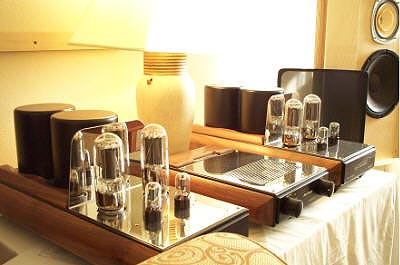 |
|||||||||||
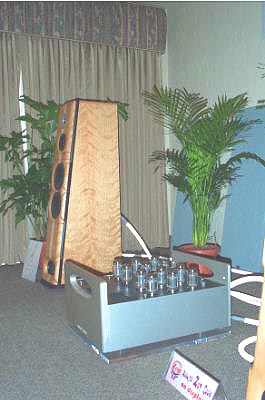 |
|||||||||||
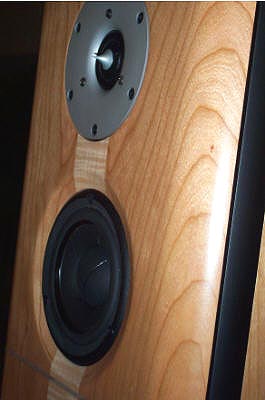 |
|||||||||||
| Meanwhile, sunk into a couch like a sloppy Saint Bernard, Big Andy Singer was rocking down the house with Johnny Rotten at ungodly levels, suggesting serious hearing loss or utter disregard for fellow visitors. Considering his mercurial temperament and infamous tact, 'twas probably a bit of both. Which doesn't take away from his influence nor the fact that he intimidates most people with an investment of being liked by him. | |||||||||||
| Such uncompressed party levels were obtained courtesy of Meadowlark Audio's new Blue Heron2 ($12,000) driven by Mark O'Brian's testosterone-surely 250/170w ultralinear/triode Rogue Audio Zeus amplifier ($6,000). Did those pointy Madonna-style nipples on Scanspeak's dearest ring-radiator incite such a massive cockstand of output lust? Whatever the case may have been, the Blue Herons survived the punishment without flinching a feather. I took that as clear vindication that the BassIC impedance-coupled bass alignment successfully prevented woofer bottoming or any other signs of more common distress. Pat and Lucinda McGinty held more refined court next door to showcase their new Kestrel2 and larger Osprey 3-way. The curved glass-block wall behind the speakers caused a few resonant reflections unless you observed just the right distance, but I was particularly impressed by the 6.5" 2-way Kestrel2 ($1,695). It plumbed the depth in defiance of size, cost and physics, imaged and focused like a bandit and, as driven via the Rogue Audio Tempest Magnum Integrated, exhibited becoming warmth without getting unduly fuzzy on the edges. Both Meadowlark rooms used Grand Prix Audio vibration isolation equipment supports, a trend that also included Avantgarde-USA, AUDIOPAX, BAT, Eggleston Works/Art Audio, Manley Labs/Coincident Speaker Technologies, McCormack Audio and Thiel. I predict that by next year's CES, the renown of Alvin Lloyd at GPA will have established him as the definitive go-to guy when it comes to top-performance racks. Briefly talking to Alvin post-show to order some of his new Apex footers for my Avantgardes (stay tuned!), he shared that John Atkinson was just about to order some of his equipment supports for personal use. "No ink, just a check" seems to have been the gist of that handshake deal. Happy trails on the fast track of Grand Prix Audio, JA - you'll be shocked! |
|||||||||||
 |
|||||||||||
 |
|||||||||||
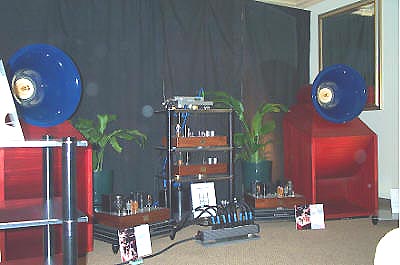 |
|||||||||||
Moondog Audio's Ron Welbourne, as it turns out, might one of these days feel compelled to make the drive from Highlands Ranch/Colorado and drop off a review system at yours truly's in neighboring Taos/New Mexico. |
|||||||||||
| He was showing both with Fred Voltz' Emotive Audio amplifiers and his own. (Expect lower-priced entries from Emotive in short order, with the new $4,495 Poeta 5687 twin-triode, 6186 cathode-follower line-stage merely being the first). Nestled above between the Little Blue Maya horns ($16,000), the new Symposium Acoustics Isis rack ($1,995 for four-level structure with integral magnetic rollerblock decoupling) makes a turn-about from the super-rigid philosophy previous Symposium racks embodied. It incorporates multiple degrees of freedom as also exploited in Grand Prix Audio's Monaco design but continues to employ metal for its load-bearing elements. This perhaps bridges formerly espoused engineering principles and those alive at Symposium today. |
|||||||||||
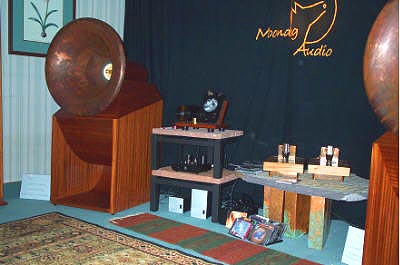 |
The Moondog Maya horn system ($17,000/pr) combines the new BD-Design Oris copper-plated ABS plastic horns loading the same new AER MKII driver as the Little Blue Maya horns, albeit with a bigger (and differently finished) horn. The matching new Yote 2A3 SET ($5,900) sports an all-copper chassis, avoids any electrolytic capacitors, uses AC filaments and pumps out a massive 3.5 watts (that's 2.5 watts more than 1 to you heavyweights). It's available in mahogany copper or blue/green tinted distressed patina for that sunbleached desert look of the 4 corners. Audiophiles who insist that horns are conceptually flawed and suffer all kinds of nameless distortions really ought to put preconceptions aside. Listen with your ears instead of eyes or beliefs. While I won't claim that horns don't exhibit distortions (what speaker doesn't), the kind they might possess is far more benign than the dynamic compression, non-linear scaling and thermal distortion most conventional designs suffer by comparison. As the whole low-power, single-ended triode debate sans feedback proves, measured and perceived distortion don't mean the same thing by a long shot. |
||||||||||
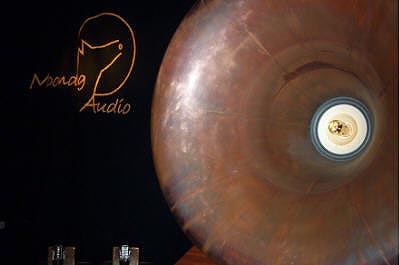 |
|||||||||||
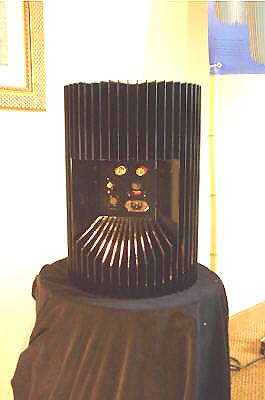 |
|||||||||||
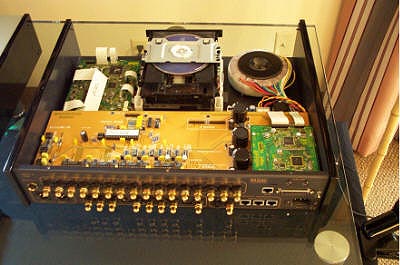 |
|||||||||||
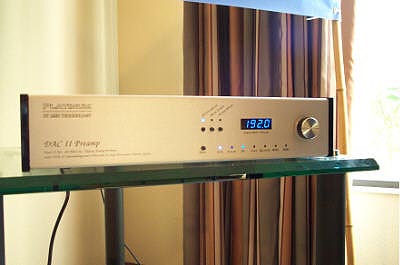 |
|||||||||||
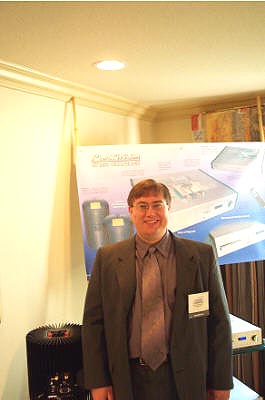 |
|||||||||||
MSB displayed a plethora of new Reference-Series product poised to invade dealers worldwide while the lower-priced product will remain in the current distribution channels. The Super DVD Audio player/processor/preamp ($7,995, top left) plays SACD, DVD-A, DTS CDs, standard CD/CD-R/CD-RW and MP3s, uses 24/192 DACs, 192 MSB upsampling, volume-controlled analog outputs with a path-thru and all types of digital outputs including IEEE 1394 Firewire and the MSB proprietary Network. Video is handled via 108MHz 12-bit DACs and 8 channels of audio are supported. An advanced surround-sound system merely requires add-on amps, speakers and presto - a simple remote controls basic function, a complex one handles advanced programming. |
|||||||||||
The DAC II Preamp ($5,995, below) is described as a dual 24-bit 100Mbit/sec sign-magnitude R2R ladder DAC with four discrete converters and remote controlled stepped attenuator. The new Reference CD Station II ($7,995) is the next-gen Platinum CD Player and now offers the same remote volume functionality as the DAC II Preamp. Resident techno wizard Dustin Szymanski poses for posterity next to the new Platinum Mono 200 amplifier ($9,995/pr) about which little else of substance is revealed yet except to taunt us with "unique all MSB top-to-bottom design". Two exceptionally good-sounding rooms (AUDIOPAX and Galante/Art Audio/VBT) used the older and present integrated MSB CD player as sources, making my cloudy crystal ball predict in warbling tones that MSB perhaps had something to do with those reactions of aural delight? |
|||||||||||
 |
 |
||||||||||
 |
|||||||||||